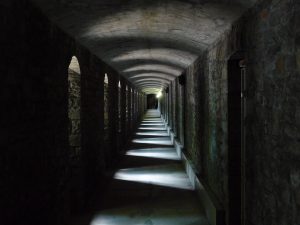Bearings
Where Can I Run To?
Creating Sacred Space as a Black Woman
By Hazel Cherry
December 2017 Issue

The 1990s R&B girl group, Xscape, has a famous song entitled “Who Can I Run To?” The song discusses the complexity of whom to rely on when one needs love. I can relate.
I entered my thirties this year full of hope, only to be hit with three significant losses in a six-month time span. I lost the love of my life, then my job, and then my father passed. It didn’t stop there. When my father passed, I realized I was still grieving a miscarriage from a year prior.
All of this grief swirls against my constant reality: I am a Black Woman carrying the weight of racism, sexism, and classism. Daily. I am not a super human. My grief is a natural response to both personal and communal loss. Adapting Xscape’s lament in song, I ask, where is there space for Black women like me? For those of us who do not feel hope because grief is too much? Where is the space for me in sacred community? Where is the sacred space that affirms my grieving as holy, too?
After my father’s death, I felt a numbness that I had never experienced before. Part of me was mourning the fact that I wasn’t with him when he passed, another part was mourning the memories, and still another was mourning the memories we were unable to make.
It was clear to me that during this time I needed something other than what a traditional church space could offer me. Where, I kept wondering, is the sacred space that could hold my discontentment with God? Where is the sacred space that doesn’t rush to the Resurrection but will sit with me in my garden of Gethsemane? Or, where is the sacred space for those of us who find ourselves lynched by life’s tragedies and are at the point, like Jesus, of asking God, “why have you forsaken for me?”
My grief pushed me less towards an external being and towards what St. Teresa of Avila describes as “the interior castle.” I recalled Teresa’s spiritually radical guidance:
"This magnificent refuge is inside you. Enter. Shatter the darkness that shrouds the doorway. Step around the poisonous vipers that slither at your feet, attempting to throw you off your course. Be bold. Be humble. Put away the incense and forget the incantations they taught you. Ask no permission from the authorities. Slip away. Close your eyes and follow your breath to the still place that leads to the invisible path that leads you home."
 This was my “aha” moment. I needed to create my own sacred space. So, I began to ask myself two things. First, what would a sacred space that was not for male consumption look like? And what would it look like in praxis if I engaged the Divine as a Black Woman?
This was my “aha” moment. I needed to create my own sacred space. So, I began to ask myself two things. First, what would a sacred space that was not for male consumption look like? And what would it look like in praxis if I engaged the Divine as a Black Woman?
Historically, Black women have always created alternate space for themselves. There were generations of women whose lead I could follow. So, with courage, I decided to meet grief with a “yes”—a “yes” to what the “invisible path” would reveal to me. I decided instead of rushing through it, or suppressing it, I’d be guided by the wealth of Black Women’s wisdom. For instance, after my miscarriage, God’s voice often sounded to me like the voice of my grandmother. I listened for that voice again.
When I prayed, I imagined God as a Black Woman; she knew me. She connected with my struggles. My worries were not abstract to her. She knew what it meant to be in constant fear of being harmed. She knew how I felt when I did not want to get out of bed nor put on makeup. She knew how hard it was for me to preach on a Sunday morning having just memorialized my father the week before. She knew what it felt like to want to be held and be tended to.
Companioned by God as a Black Woman, my rituals changed. I made a playlist entitled ‘Black Girl Heal’ featuring Black women artists such as, India Arie, Nina Simone, Ledisi, Me'Shell NdegéOcello, and Lauryn Hill. When Ledisi sang “So when you look at my face / You gotta know that I'm made / Of everything love and pain,” I found a space in which I was truly known, a space where I could face my grief because I could feel it so deeply.
I also decided to change my journaling style to the format of Alice Walker’s The Color Purple. I began each entry with “Dear God,” and I gave her a name that felt comforting. Sometimes it was God as Grandmother, or God as some of the names of my closest friends, or historical women such as Sojourner Truth and Frances Ellen Watkins Harper. Writing this way, I was able to be more free and honest. My reflections were less about getting answers from a spiritual being, and more about tapping into the anguish and disappointment and connecting me to women who had overcome what I was enduring.
For release of stress, I decided to go dancing at least twice a month. This ritual served as reminder to let go. There is something deeply spiritual ancestrally about dancing. Personally, it is when I feel most free. I was committed to moving with fervor as it removed every ache and pain. I danced out of desperation to escape any part of me that did not feel at ease.
Grieving has in many ways isolated me. I have less energy to be around people for long periods of time. I worry about how others will react to my sadness and I am cautious about how my energy will affect others. Nonetheless, I do believe that we must stay close to our community of support. Thus, I committed to meet in person with my close friends at least once a week. Their smiles and encouragement are a reminder that I am loved and that my life is bigger than my grief.
Finally, I used my weekly bath time as a renewed baptism. For most of my life, I have always felt deeply connected to water. Each week, I would take an elaborate bath. I’d infuse the water with bath balms and oils, and soak my body. I’d say a prayer and immerse myself in the water, floating in each Sunday’s affirmation that a new beginning is possible this week.

Through all of this, I have begun to create a space within myself and within my life that I can truly name as “sacred.” This space is discovered, first, in the deep acknowledgment of what we need and a commitment to making those needs priority. When in pain we can often be tempted to seek external refuge, but I found that going deep within myself helped me to chart a different path towards healing. On this path, we are not on the margins, we are not fighting to feel heard or affirmed. On this path, we are not waiting for a male rescuer or savior. In this sacred space, our healing and transformation are at the center, guided and consoled by the voice of God Our Mother, God Our Grandmother, God Our Sister, God Our Friend.
Whose voice calls you to divine healing? What rituals mark sacred space in yourself and your life? “Slip away. Close your eyes and follow your breath to the still place that leads to the invisible path that leads you home.”
Photo Credits:
Cover Image: Chris Barbalis, “Graffiti woman with cool hair” (August 22, 2017). Via Unsplash. CC2.0 license.
Inside Image 1: Ben Gibbs, "A tunnel in Cardiff Castle" (May 22, 2011). Via Flickr. CC2.0 license.
Inside Image 3: Ed Shelley, "Untitled" (December 4, 2017). Via Unsplash. CC2.0 license.

